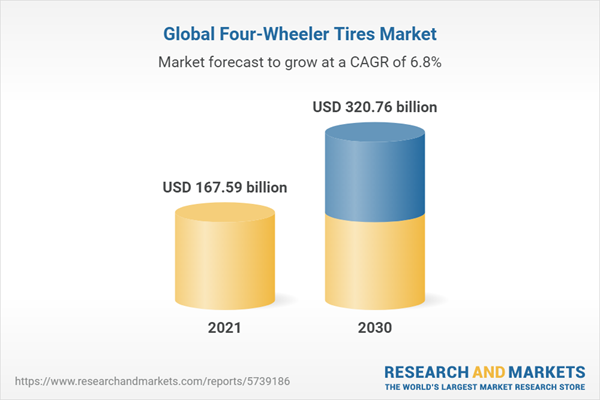The global four-wheeler tires market held a market value of USD 167.59 billion in 2021 and is estimated to reach USD 320.76 billion by the year 2030. The market is projected to list a CAGR of 6.8% during the forecast period.Global Four-Wheeler Tires Market is projected to grow at a CAGR of 6.9% during the forecast period 2022-2030
The advent of numerous cutting-edge technology, rising car sales, and replacement cycles have all impacted demand trends in the sector. The safety, effectiveness, and total mileage of a vehicle are greatly influenced by the tyres. The development of sophisticated tyres that aid in better grip and durability as a result of increased R&D investments has increased demand. Unfavorable weather, road conditions, and vehicle overloading are also anticipated to increase market demand throughout the projection period.
The increasing strategic activities of companies fuels the growth rate of the market. For instance, Apollo Tires launched a new product in cross-ply technology for the commercial vehicle (CV) segment in India in April 2021. In addition to that, JK Tire established a cooperation with JBM Auto in April 2021 to supply radial tyres for JBM Auto's CITYLIFE CNG and ECOLIFE electrified buses. Also, Nokian Tyres PLC announced in March 2021 that it will increase its passenger car tyre production capacity at its Finnish facilities by roughly 30%.
Rapid infrastructure development in developing economies, particularly India and China, has resulted in an increase in commercial vehicle and construction vehicle sales. Vehicle manufacturers can make significant money from the replacement and aftermarket tyre industry. Customers prefer high-performance tyres to ordinary rubber tyres because rubber tyres wear and break readily.
Growth Influencers:
Government investments in logistics & transportation
As businesses strive to become carbon neutral by 2050, they are using green energy in their tyre manufacturing processes. They are doing this by making investments in green energy, energy-efficient equipment, and zero-carbon products. For instance, the Michelin Group declared in February 2021 that it was trying to have all of its tyres completely sustainable by the year 2050. Michelin collaborated on this with a number of groups, including Axens, IFP Energies Nouvelles, Pyrowave, Carbios, Enviro, and BlackCycle.Increasing vehicle production
The rising demand and sales of vehicles boosts the growth of the market. For instance, India is another important market in the area. After a rough third quarter, passenger vehicle sales there improved and reached 3,10,294 units in October 2020, up 14.19% from 2,71,737 units in the same month last year. The Federation of Automobile Dealers Associations (FADA) reports that passenger vehicle sales increased by 4.17% in November 2020 to 2,91,001 units from 2,79,365 units in November 2019. The sales of new car tyres for vehicles in 2020 decreased by 36,439,000, or 17%, year over year, according to the '2020 Domestic Demand for Automobile Tires' report published by the Japan Automobile Tyre Manufacturers Association (JATMA). Due to COVID-19's impact, the first half of 2020 was impacted; nevertheless, demand for new car tyres started to propel soon after.Segments Overview:
The global four-wheeler tires market is segmented into tire type, operation type, application, weight, distribution channel.By Tire Type
- Radial
- Bias
By Operation Type
- Steer
- Drive
- Trailer
By Application
- Passenger Cars
- Light Trucks
- Truck
- Bus
- Off-Road Vehicles
By Weight
- < 50 Kg
- 50 - 80 Kg
- 81 - 100 Kg
- 101 - 150 Kg
- > 150Kg
By Distribution Channel
- OEMs
- Aftermarket
Regional Overview
By region, the global four-wheeler tires market is divided into North America, Asia Pacific, Europe, Middle East & Africa, and South America. The Asia Pacific market held the largest market share of more than 40% in 2021, with a revenue of USD 75.28 billion.Competitive Landscape
The prominent players operating in the global four-wheeler tires market include Aeolus Tyre, Bridgestone, Cheng Shin Rubber, Continental, Cooper tire, Double Coin, Giti Tire, Goodyear, Hankook, KUMHO TIRE, Linglong Tire, Michelin, Pirelli, Sumitomo Rubber, Toyo Tires, Triangle Tire Group, Xingyuan group, YOKOHAMA, ZC Rubber, and others. The top ten players in the market held around 65% market share.The global market is mid-level consolidated, with major producers like as Michelin, Bridgestone, Pirelli, and others catering to both passenger and commercial vehicle tyre needs. However, in regional and highly concentrated Asian vehicle markets such as China, India, and Indonesia, domestic tyre makers dominate the market. The desire for high-quality, safe tyres drove automakers and end-users to prefer products from well-known manufacturers over smaller regional players. Furthermore, these big players have increased their R&D spending exponentially to integrate innovation with performance excellence. As a result, high quality tyres for off-road and on-road applications have been developed. For instance, Toyo Tires generated 90.1% of the revenue from its business unit, tire, in 2021.
The global four-wheeler tires market report provides insights on the below pointers:
- Market Penetration: Provides comprehensive information on the market offered by the prominent players
- Market Development: The report offers detailed information about lucrative emerging markets and analyzes penetration across mature segments of the markets
- Market Diversification: Provides in-depth information about untapped geographies, recent developments, and investments
- Competitive Landscape Assessment: Mergers & acquisitions, certifications, product launches in the global four-wheeler tires market have been provided in this research report. In addition, the report also emphasizes the SWOT analysis of the leading players
- Product Development & Innovation: The report provides intelligent insights on future technologies, R&D activities, and breakthrough product developments
- Pricing Analysis: Pricing analysis of various components used in the manufacturing of four-wheeler tires
- Manufacturing Cost Analysis: Cost-share of various components in four-wheeler tires tools
- Share of 4-wheeler tire in global industry
- Tire growth, by volume
- Raw material for a tire
The global four-wheeler tires market report answers questions such as:
- What is the market size and forecast of the global four-wheeler tires market?
- What are the inhibiting factors and impact of COVID-19 on the global four-wheeler tires market during the assessment period?
- Which are the products/segments/applications/areas to invest in over the assessment period in the global four-wheeler tires market?
- What is the competitive strategic window for opportunities in the global four-wheeler tires market?
- What are the technology trends and regulatory frameworks in the global four-wheeler tires market?
- What is the market share of the leading players in the global four-wheeler tires market?
- What modes and strategic moves are considered favorable for entering the global four-wheeler tires market?
Table of Contents
Chapter 1. Research Framework
Chapter 3. Global Four-Wheeler Tires Market Overview
Chapter 4. Competition Dashboard
Chapter 5. Four-Wheeler Tires Market Analysis, By Tire Type
Chapter 6. Four-Wheeler Tires Market Analysis, By Operation Type
Chapter 7. Four-Wheeler Tires Market Analysis, By Applications
Chapter 8. Four-Wheeler Tires Market Analysis, By Weight
Chapter 9. Four-Wheeler Tires Market Analysis, By Distribution Channel
Chapter 10. Global Four-Wheeler Tires Market Analysis, By Region
Chapter 11. North America Four-Wheeler Tires Market Analysis
Chapter 12. Europe Four-Wheeler Tires Market Analysis
Chapter 13. Asia Pacific Four-Wheeler Tires Market Analysis
Chapter 14. Middle East & Africa Four-Wheeler Tires Market Analysis
Chapter 15. South America Four-Wheeler Tires Market Analysis
Chapter 16. Company Profile (Company Overview, Financial Matrix, Key Product landscape, Key Personnel, Key Competitors, Contact Address, and Business Strategy Outlook)
Executive Summary
The global four-wheeler tires market is likely to grow significantly over the forecast period owing to the increasing investments in transportation and logistics sector, coupled with rising vehicle production. The market is anticipated to reach USD 320.76 billion by 2030. Moreover, the key market players are actively involved in strategic initiatives, such as product launches, and joint ventures. Furthermore, the Asia Pacific market for four-wheeler tires held the largest market share owing to the presence of well-established players in the countries. The market is segmented based on type, operation type, application, weight, distribution channel.Companies Mentioned (Partial List)
A selection of companies mentioned in this report includes, but is not limited to:
- Aeolus Tyre
- Bridgestone
- Cheng Shin Rubber
- Continental
- Cooper tire
- Double Coin
- Giti Tire
- Goodyear
- Hankook
- KUMHO TIRE
- Linglong Tire
- Michelin
- Pirelli
- Sumitomo Rubber
- Toyo Tires
- Triangle Tire Group
- Xingyuan group
- YOKOHAMA
- ZC Rubber
Table Information
| Report Attribute | Details |
|---|---|
| No. of Pages | 270 |
| Published | December 2022 |
| Forecast Period | 2021 - 2030 |
| Estimated Market Value ( USD | $ 167.59 billion |
| Forecasted Market Value ( USD | $ 320.76 Billion |
| Compound Annual Growth Rate | 6.8% |
| Regions Covered | Global |









